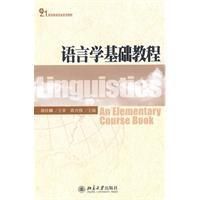圖書信息
書名:語言學基礎教程作者:苗興偉 主編
出版社:北京大學出版社
出版時間:2010-7-1
字數:249000
版次:1
頁數:238
 語言學基礎教程
語言學基礎教程印刷時間:2010-7-1
開本:16開
印次:1
紙張:膠版紙
ISBN:9787301138397
包裝:平裝
定價:32.00元
內容簡介
在內容方面,本書在提供基本知識的同時,更注重教材的科學性、系統性、實用性和時代性。在編寫過程中,我們力求“化難為簡”,儘量做到概念清晰,既要保證知識的系統性,又要避免術語的堆砌。圖書目錄
Chapter1LanguageandLinguistics1.1Whatislanguage?
1.2Thedesignfeaturesoflanguage
1.3Theoriginoflanguage
1.4Whatislinguistics?
1.5Thescopeoflinguistics
1.6Abriefhistoryoflinguistics
1.6.1Saussureasthefatherofmodernlinguistics
1.6.2Americanstructuralism
1.6.3Generativelinguistics
1.6.4Functionallinguistics
QuestionsandExercises
Chapter2PhoneticsandPhonology:TheSoundsandSoundPatternsofLanguage
2.1Introduction
2.2Phonetics
2.2.1Speechorgans
2.2.2Consonants
2.2.3Vowels
2.2.4Transcriptionofspeechsounds
2.3Phonology
2.3.1phoneme
2.3.2Phoneandallophone
2.3.3Phonotacties
2.3.4Prosodicfeatures:stress,toneandintonation
2.3.5Co-articulationeffects
2.4Summary
QuestionsandExercises
Chapter3Morphology:TheWordStructureofLanguage
3.1Introduction
3.2Thewordsoflanguage
3.3Thestructureofwords
3.4morpheme,morphandallomorph
3.5Classificationofmorphemes
3.5.1Freemorphemesandboundmorphemes
3.5.2Rootsandaffixes
3.5.3Inflectionalmorphemesandderivationalmorphemes
3.6Wordformationprocesses
3.6.1Derivation
3.6.2Compounding
3.6.3Conversion
3.6.4Blending
3.6.5Backformation
3.6.6Abbreviationorshortening
3.7Summary
QuestionsandExercises
Chapter4Syntax:TheSentenceStructureofLanguage
4.1Introduction
4.2Sentencestructure
4.2.1Definitionofsentence
4.2.2Thelinearstructureofsentence
4.2.3Thehierarchicalstructureofsentence
4.3Thetraditionalapproach
4.4Thestructuralapproach
4.4.1Immediateconstituentanalysis
4.4.2Endocentricandexocentricconstructions
4.5Thetransformational-generativeapproach
4.5.1TheTGmodelofgrammar
4.5.2Syntacticstructure
4.5.3Movement
4.6Thefunctionalapproach
4.6.1Functionsoflanguage
4.6.2Functionalanalysisofsyntacticstructure
4.7Summary
QuestionsandExercises
Chapter5Semantics:TheMeaningofLanguage
5.1Introduction
5.2Approachestomeaning
5.3Senseandreference
5.4Wordmeaning
5.4.1Grammaticalmeaningandlexicalmeaning
5.4.2Classificationoflexicalmeaning
5.4.3Senserelations
5.4.4Semanticfield
5.5Sentencemeaning
5.5.1Definitionofsentencemeaning
5.5.2Semanticrelationsatthesententiallevel
5.6Ambiguity
5.7Semanticanalysis
5.7.1ComponentialAnalysis
5.7.2PredicationAnalysis
QuestionsandExercises
Chapter6Pragmatics:TheUseofLanguageinContext
6.1Introduction
6.2Pragmaticsasanewbranchoflinguistics
6.2.1Definingpragmatics
6.2.2Syntax,semanticsandpragmatics
6.3SpeechActTheory
6.3.1Constativesandperformatives
6.3.2locution,illocution,andperlocution
6.3.3Felicityconditions
6.3.4Classificationofspeechacts
6.4Theoryofconversationalimplicature
6.4.1Thenotionofimplicature
6.4.2CooperativePrincipleanditsmaxims
6.4.3Floutingthemaxims
6.5PolitenessPrinciple
6.5.1Politeness:Theprincipleandthemaxims
6.5.2Clashesbetweenthemaxims
6.6Summary
QuestionsandExercises
Chapter7DiscourseAnalysis:LanguageabovetheSentence
7.1Introduction
7.2Whatisdiscourseanalysis?
7.3Cohesion
7.3.1Reference
7.3.2Substitution
7.3.3ellipsis
7.3.4Conjunction
7.3.5Lexicalcohesion
7.4Coherence
7.5Thestructureofdiscourse
7.5.1Thematicstructureandinformationstructure
7.5.2Thestructureofconversations
7.5.3Patternsinwrittendiscourse
7.6Connections
QuestionsandExercises
Chapter8HistoricalLinguistics:LanguagethroughTime
8.1Introduction
8.2Whenlanguagechanges
8.3Howlanguagechanges
8.3.1Phonologicalchange
8.3.2Lexicalchange
8.3.3Grammaticalchange
8.4Whylanguagechanges
8.4.1Externalcauses
8.4.2Internalcauses
8.5Summary
QuestionsandExercises
Chapter9Stylistics:LanguageandLiterature
9.1Introduction
9.2Importantviewsonstyle
9.2.1Styleasdeviation
9.2.2Styleaschoice
9.2.3Styleasforegrounding
9.3Stylisticanalysis
9.3.1Phonologicalanalysis
9.3.2Graphologicalanalysis
9.3.3Lexicalanalysis
9.3.4Syntacticanalysis
9.3.5Semanticanalysis
9.3.6Pragmaticanalysis
QuestionsandExercises
Chapter10Sociolinguistics:LanguageandSociety
10.1Introduction
10.2Therelationsbetweenlanguageandsociety
10.3Speechcommunityandspeechvariety
10.4Dialect
10.4.1Regionaldialect
10.4.2Socialdialect
10.4.3Standarddialect
10.5Register
10.6Languagecontactandcontactlanguages
10.6.1Linguafranca
10.6.2Pidgin
10.6.3Creole
10.7Choosingacode
10.7.1Diglossia
10.7.2Bilingualism
10.7.3Code-switching
QuestionsandExercises
Chapter11InterculturalCommunication:LanguageandCulture
11.1Introduction
11.2Definitionsofculture
11.3Therelationshipbetweenlanguageandculture
11.4Namingtheworldthroughlanguage
11.4.1Colorterms
11.4.2Kinshipterms
11.4.3Culture-loadedwords
11.5Communicativepatternsacrosscultures
11.5.1Addressforms
11.5.2Greetings
11.5.3Givingandacceptingcompliments
11.5.4Highcontextversuslowcontext
11.6Languageandthought:Sapir-Whorfhypothesis
11.7Interculturalcommunication
11.7.1Interculturalcommunicationasafieldofresearch
11.7.2Conqueringobstaclesininterculturalcommunication
11.7.3Valuedimensions
11.8Summary
QuestionsandExercises
Chapter12Psycholinguistics:LanguageandPsychology
12.1Introduction
12.2Languageandthebrain:Thebiologicalfoundationsoflanguage
12.2.1Cerebrallateralizationandlanguagefunctions
12.2.2Evidenceoflateralization
12.3Languagecomprehension
12.3.1Humaninformationprocessingsystem
12.3.2Thementallexicon
12.3.3Sentencecomprehension
12.3.4Discoursecomprehension
12.4Languageproduction
12.5Languageacquisition
12.5.1Firstlanguage,secondlanguageandforeignlanguage
12.5.2Firstlanguageacquisition
12.5.3Secondlanguageacquisition
QuestionsandExercises
Chapter13CognitiveLinguistics:LanguageandCognition
13.1Introduction
13.2Categoriesandcategorization
13.3Conceptualmetaphors
13.4Conceptualmetonymies
13.5Imageschemas
13.6Iconicity
13.6.1Iconicityoforder
13.6.2Iconicityofdistance
13.6.3Iconicityofcomplexity
QuestionsandExercises
Chapter14AppliedLinguistics:LanguageTeachingandLearning
14.1Introduction
14.2Howislanguagelearned?
14.2.1behaviorism
14.2.2Theinnatenesshypothesis:universalgrammar
14.2.3Interlanguagetheory
14.2.4Theinputhypothesis
14.2.5Theoutputhypothesis
14.3Individualdifferencesinlanguagelearning
14.3.1Languageaptitude
14.3.2Learningstyle
14.3.3Motivation
14.3.4Anxiety
14.3.5Learningstrategies
14.4Approachesandmethodsinforeignlanguageteaching
14.4.1TheGrammar-TranslationMethod
14.4.2TheDirectMethod
14.4.3TheAudiolingualMethod
14.4.4TheCommunicativeApproach
14.4.5TheTask-basedApproach
14.5LanguageTesting
14.5.1Typesoftest
14.5.2Qualitiesofagoodtest
QuestionsandExercises
References
Glossary
